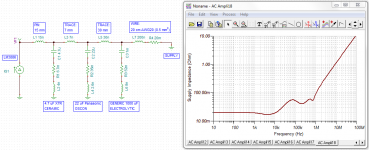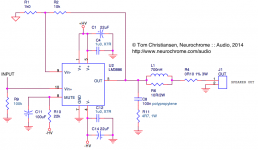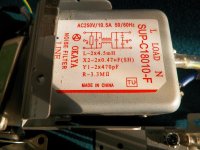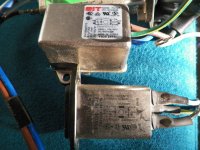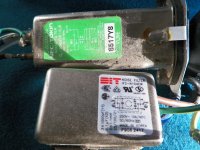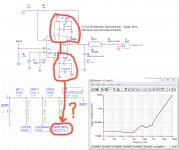the layout is quite similar to your P-2-P v4.Yeah, but have you measured the THD at 100 Hz, 1 kHz, 10 kHz, and 20 kHz at max output power. That's the real test. If you muck up the layout, your THD will be 10-100x the number in the data sheet at 20 kHz and probably at least 5-10x higher at 1 kHz.
~Tom
so far all testing has come out clean and no unexpected heating or current consumption, all this anywhere from 0.1 v to 20v out (+/- 26v PSU).
i did notice that once connected to my linestage, the linestage grumbled a bit if running unbuffered. 1k is a bit low for it (it's a slightly modded Bamboo Retro ART-4 -- similar to the CJ GAT but without its MOSFET buffer and using 4 CCS-fed parallel 6922 bottles instead of 2). the Rp|| effective-anode-load R would be about 400 or so which is 4-5x too high for a 1k load in my estimation. i suppose i can get around this by taking the output from the mu point in the CSS instead of from the anode, but then it wouldn't be "real" tube pre.
Last edited:
epilogue: i'm thinking i'd like to try using a YJ BPA-300 board pair (that i have in the closet) as a sort of backplane and hang the parts 3-D like the current project using the board mostly as a strain relief and for the muting circuit. have to think through if i can get close to the same layout as now -- the boards may get in the way and hurt more than it helps.
No worries. The answer is: Depends... If you are connecting multiple Modulus-86 boards in parallel, bridge, or bridge/parallel, I would definitely recommend some sort of speaker protection. For a single Modulus-86 board, I, personally, wouldn't use a protection circuit.
You're more than welcome to ask Modulus-86 specific questions in the Modulus-86 thread, if you wish. I'm also reachable by email and/or PM.
~Tom
You're more than welcome to ask Modulus-86 specific questions in the Modulus-86 thread, if you wish. I'm also reachable by email and/or PM.
~Tom
Last edited:
Thank you muchly sir.
One Amp required .. only one pair of speakers intended: Tannoy GRF's
PS: My Mark Audio drivers, while 'nice' for what they are (cheap plastic drivers) they don't do much in the way of realism and depth
I won't be buying more.
Just my 2 cents worth of of paying it forward info
One Amp required .. only one pair of speakers intended: Tannoy GRF's
PS: My Mark Audio drivers, while 'nice' for what they are (cheap plastic drivers) they don't do much in the way of realism and depth
I won't be buying more.
Just my 2 cents worth of of paying it forward info
With your wiring diagram, can I build a 4 channel amp with one 2 x 24V 650 VA transformer?
That would be plenty for a four-channel amp.
Some one told me that the more channels you have with on transformer the more chances for ground loops.
Not really... You have more wires, so you have a higher chance of connecting something wrong, but that would be the case if you built four mono blocks as well.
Unlike a regular LM3886 amp, my Modulus-86 has a differential input. You can use it with single-ended connections such as RCA as well. The differential receiver, basically removes any ground loop from the signal path, so any ground loop error voltage is attenuated by some 70+ dB. In a regular LM3886 amp, that error voltage "sees" the full gain of the amp... Hence, you should get about 80-90 dB (10000-30000x) lower hum with the Modulus-86.
~Tom
You could have a look at my signature... The Modulus-86 is my latest and greatest amp design. I sell circuit boards for it so you can easily replicate the performance I'm getting.
~Tom
~Tom
I was just being a 
You make an excellent point about the power needed to power a speaker.
I like your new website layout for the LM3886.
I don't understand the power supply schematic very well, but that happens to me.
I understand 95% of schematics, but there's usually something that confuses me.
That's why I like this P2P thread.
It's fool-proof, so also me-proof hopefully.
A fraction of THD percent is the least of my worries when building an amp.
Why would some one build a tube amp when they can build a Modulus-86?
I noticed you had a pic of a valve amplifier book on your LM3886 webpage.

You make an excellent point about the power needed to power a speaker.
I like your new website layout for the LM3886.
I don't understand the power supply schematic very well, but that happens to me.
I understand 95% of schematics, but there's usually something that confuses me.
That's why I like this P2P thread.
It's fool-proof, so also me-proof hopefully.
A fraction of THD percent is the least of my worries when building an amp.
Why would some one build a tube amp when they can build a Modulus-86?
I noticed you had a pic of a valve amplifier book on your LM3886 webpage.
Dude... You should hook up with Planet10 (aka Dave) and listen to some of his creations using the MA drivers. He's about 20 minutes north of Victoria. His speaker designs are top notch.
~Tom
Thanks for the direction.. Done that tho.
Decent Sounds from the little rascals ..but hardly worth the price of admission In MY experiences.
More than dissapointing to go from an Aston Martin to an Austin Midget.
I'm used to (40 years used to) Sounds startling me.. from seemingly outside the room, being able to follow specific instruments easily and experiencing bass that vibrates my (now slightly sagging
Lowthers couldn't come close, despite years of dicking with them.
Ma/ Fostex ? .. please.
Last edited:
You make an excellent point about the power needed to power a speaker.
I like your new website layout for the LM3886.
Thank you. Expect more sections to be added.
Why would some one build a tube amp when they can build a Modulus-86?
I noticed you had a pic of a valve amplifier book on your LM3886 webpage.
I was wondering how that would be received. I took the picture a few years ago when my main focus was tube amps. I should re-shoot with a more generic book...
There are lots of reasons why someone would build by Damn Good 300B over, say, a Modulus-86. Personal preference would probably be the dominant factor. The MOD86 beats the DG300B on all measured parameters. Building a stereo MOD86 will set you back about $400 including power supply and chassis. Building a DG300B will set you back about $1500, though a budget build could probably be done for around $1000-1200... The MOD86 doesn't glow as pretty in the dark, though.
Some people prefer the tube sound. Unless we're talking about clipping, that generally means a distortion spectrum that's mostly low-order and flat versus frequency. The DG300B delivers that. The MOD86 is actually the only semiconductor amp I'm aware of that is capable of delivering a flat THD vs frequency. It also happens to exhibit mostly 2nd and 3rd order harmonic distortion. That's my guess as to why the MOD86 sounds so good and natural.
~Tom
Are the schematics below the final/best schematics for the tamed LM3886?
I should probably get a parts list together.
Is there a good power supply I can use instead of the schematic below and a giant 10-15lb transformer for this amp? The giant transformer of course is the problem not the rest of it.
Computer power supply? One of those Sure power supplies maybe can work as well?
Are any of the 3-prong plugs below of any use? They look like they have "snubbers" on them and inductors and then some pass the wires through some kind of doughnut (forgot what those are called).
I should probably get a parts list together.
Is there a good power supply I can use instead of the schematic below and a giant 10-15lb transformer for this amp? The giant transformer of course is the problem not the rest of it.
Computer power supply? One of those Sure power supplies maybe can work as well?
Are any of the 3-prong plugs below of any use? They look like they have "snubbers" on them and inductors and then some pass the wires through some kind of doughnut (forgot what those are called).
Attachments
Last edited:
Are the schematics below the final/best schematics for the tamed LM3886?
I should probably get a parts list together.
Is there a good power supply I can use instead of the schematic below and a giant 10-15lb transformer for this amp? The giant transformer of course is the problem not the rest of it.
Computer power supply? One of those Sure power supplies maybe can work as well?
Are any of the 3-prong plugs below of any use? They look like they have "snubbers" on them and inductors and then some pass the wires through some kind of doughnut (forgot what those are called).
there's no power supply schematic attached, just a decoupling schematic and the audio piece.
Jimmy: Yes. That's the latest schematic for the amplifier portion. I didn't do anything special for the supply.
To get the best performance out of the LM3886, you need to pay attention to the inductance of the ground nets. In particular, in the feedback and input ground reference. Use ground planes, properly.
~Tom
To get the best performance out of the LM3886, you need to pay attention to the inductance of the ground nets. In particular, in the feedback and input ground reference. Use ground planes, properly.
~Tom
To get the best performance out of the LM3886, you need to pay attention to the inductance of the ground nets. In particular, in the feedback and input ground reference. Use ground planes, properly.
~Tom

XR7 resistors? You mean the X7R capacitors? Have another drink... 

The 4.7 uF X7R modeled in TINA-TI was replaced with a 1 uF X7R in the actual circuit, as Mouser didn't have the 4.7 uF in stock. You should be able to recognize the 22 uF OSCON. The 1000 uF generic electrolytic can wasn't included in the LM3886 schematic. I assume that the reader has enough knowledge to read the LM3886 data sheet and include a sizable (470 uF or above) bypass cap at the power entry to the board.
~Tom

The 4.7 uF X7R modeled in TINA-TI was replaced with a 1 uF X7R in the actual circuit, as Mouser didn't have the 4.7 uF in stock. You should be able to recognize the 22 uF OSCON. The 1000 uF generic electrolytic can wasn't included in the LM3886 schematic. I assume that the reader has enough knowledge to read the LM3886 data sheet and include a sizable (470 uF or above) bypass cap at the power entry to the board.
~Tom
- Home
- Amplifiers
- Chip Amps
- LM3886 PCB vs Point-to-Point (with data)

